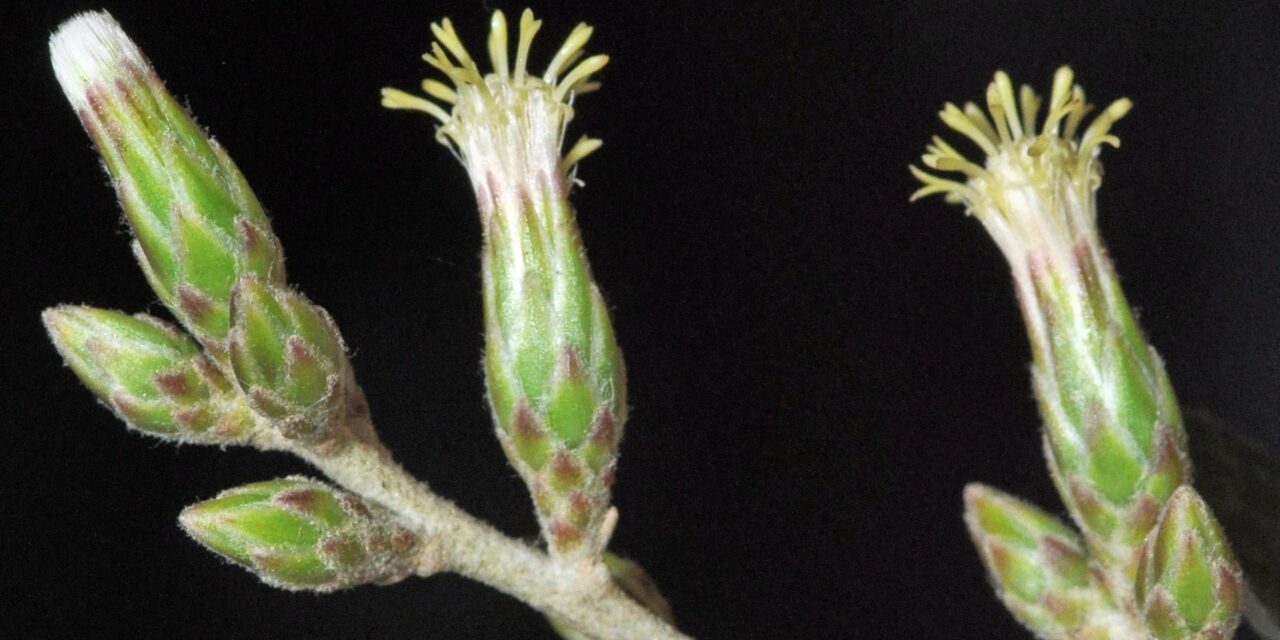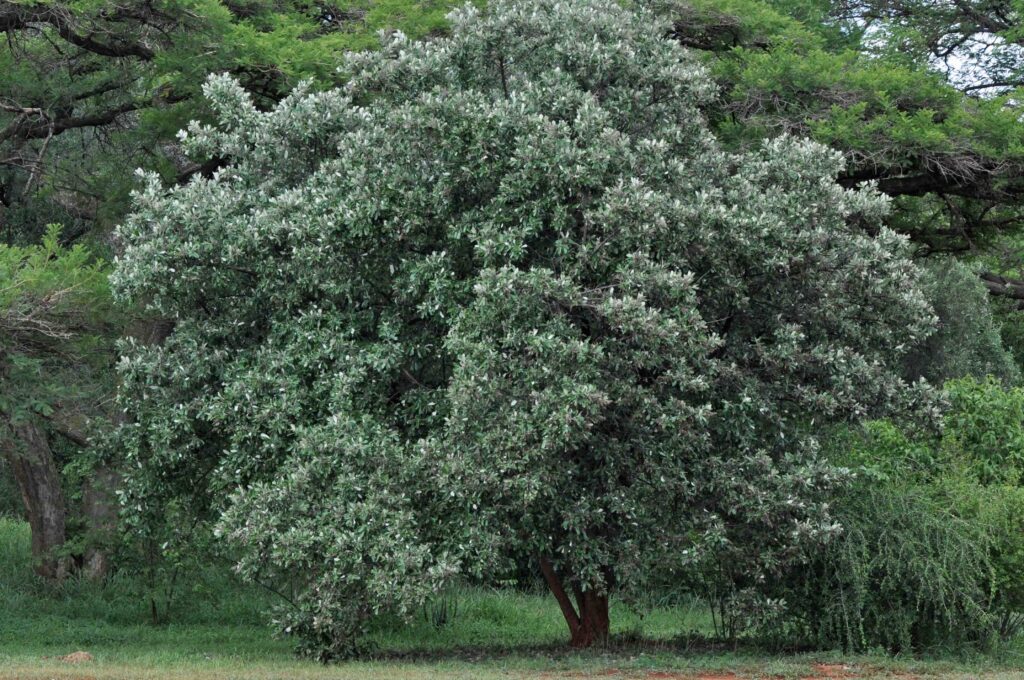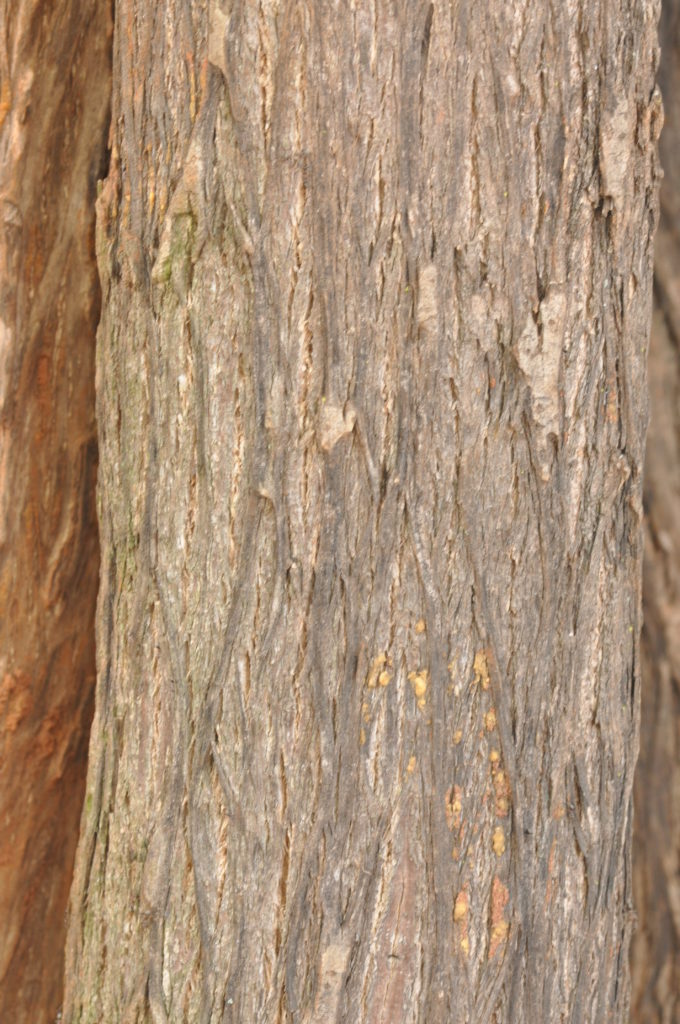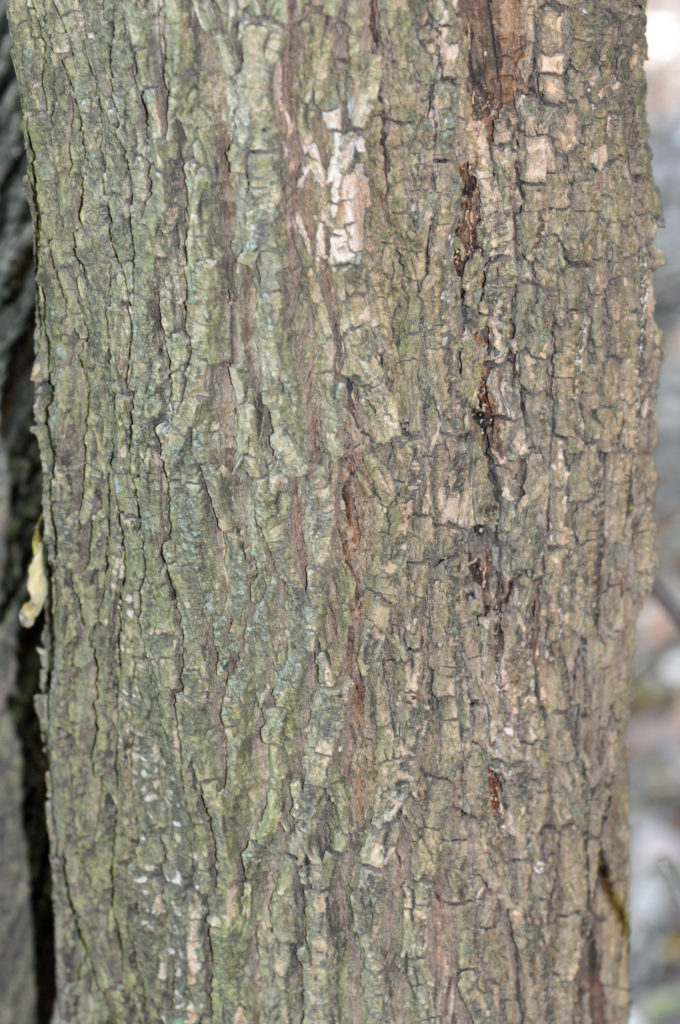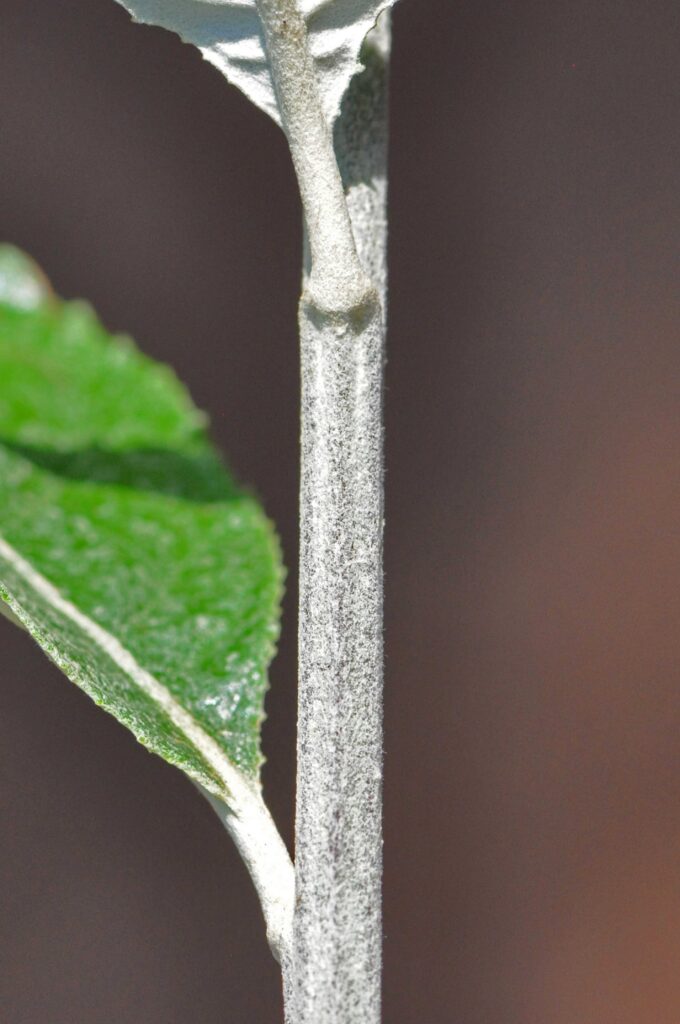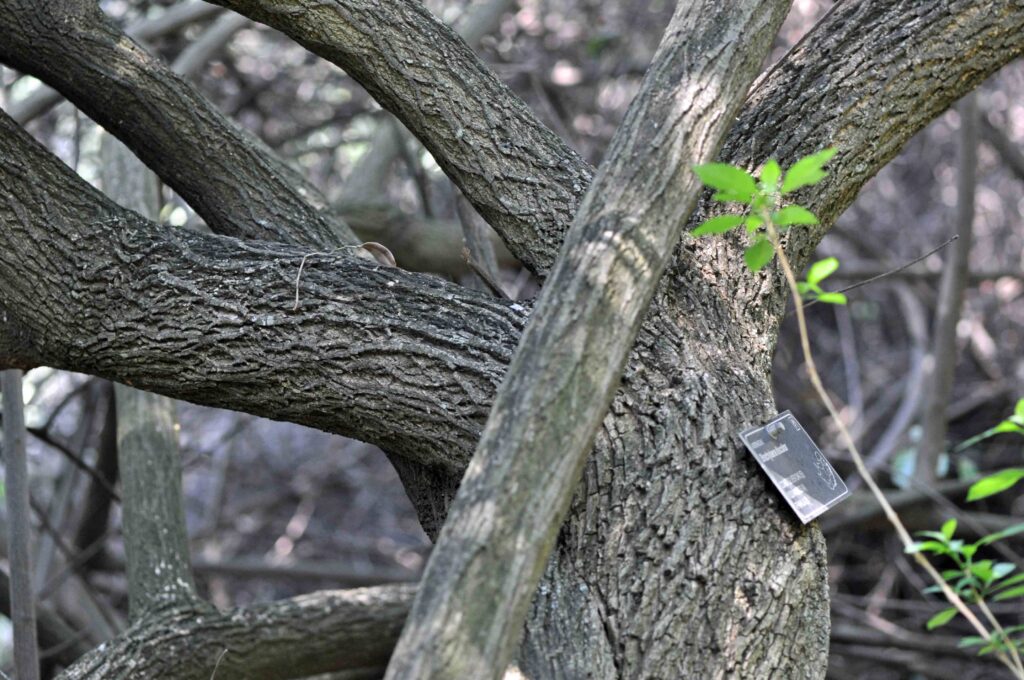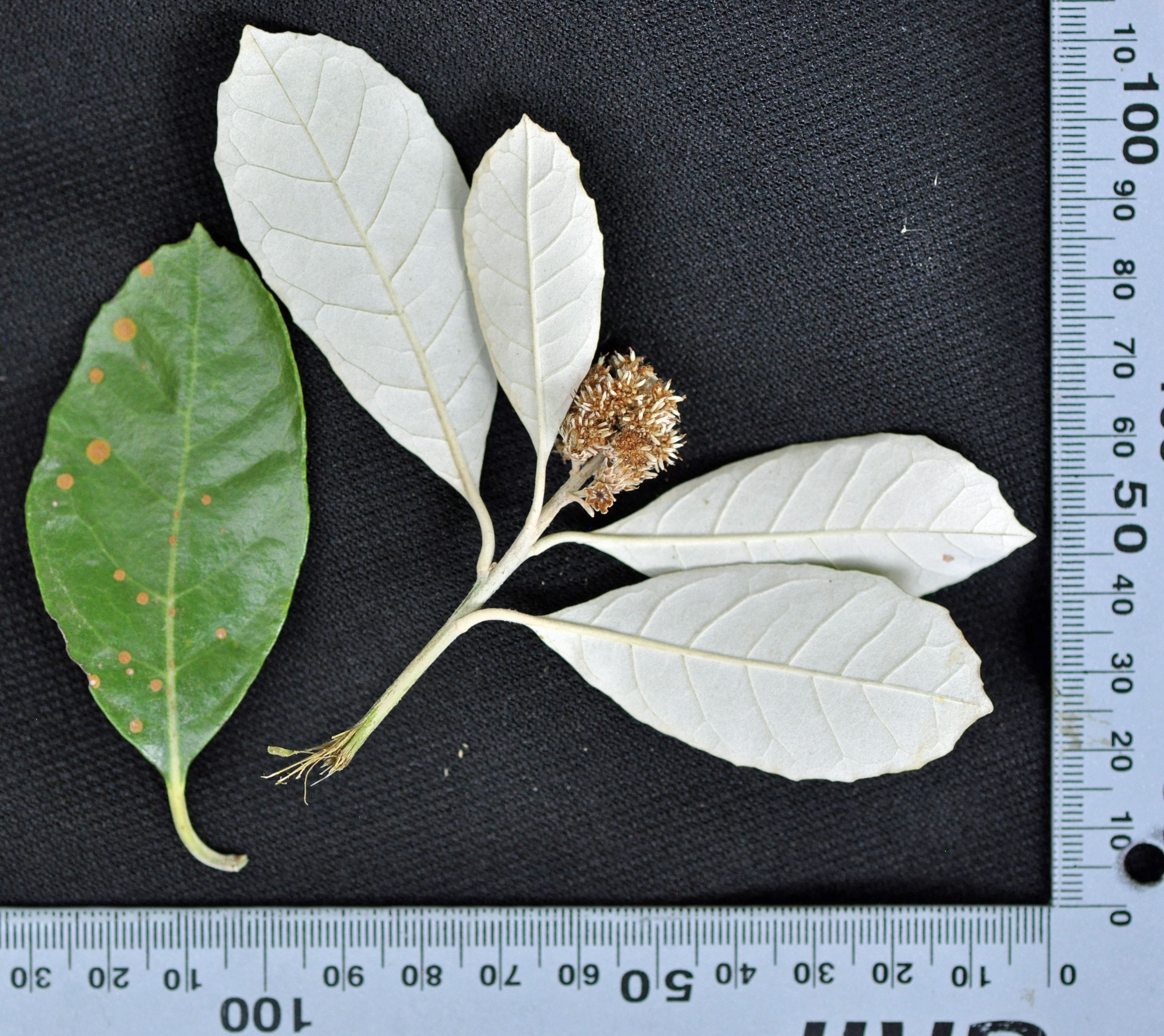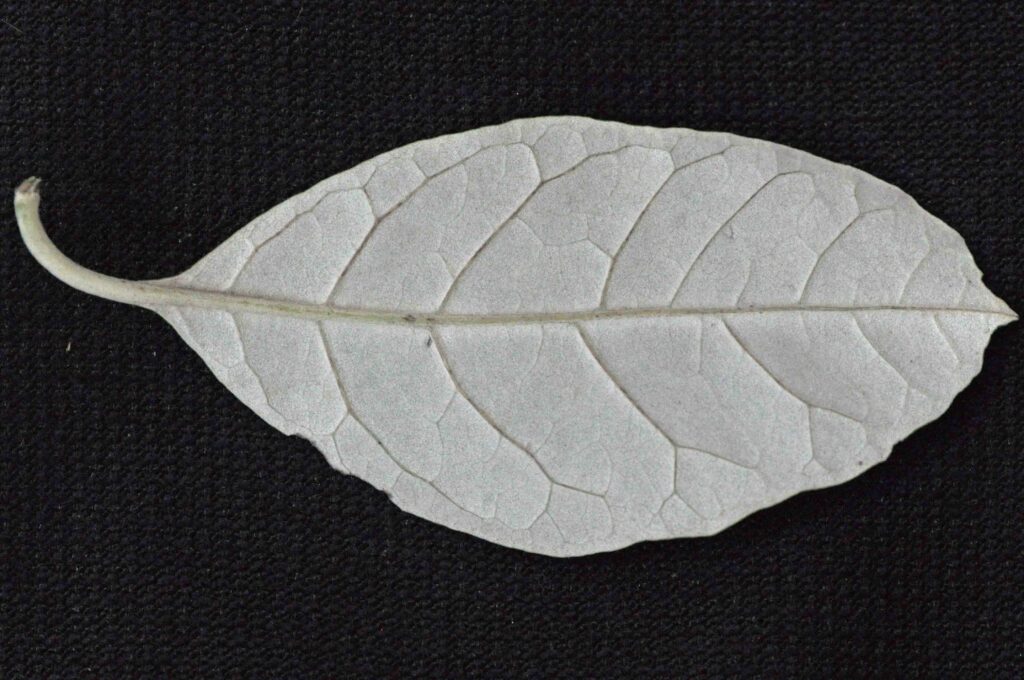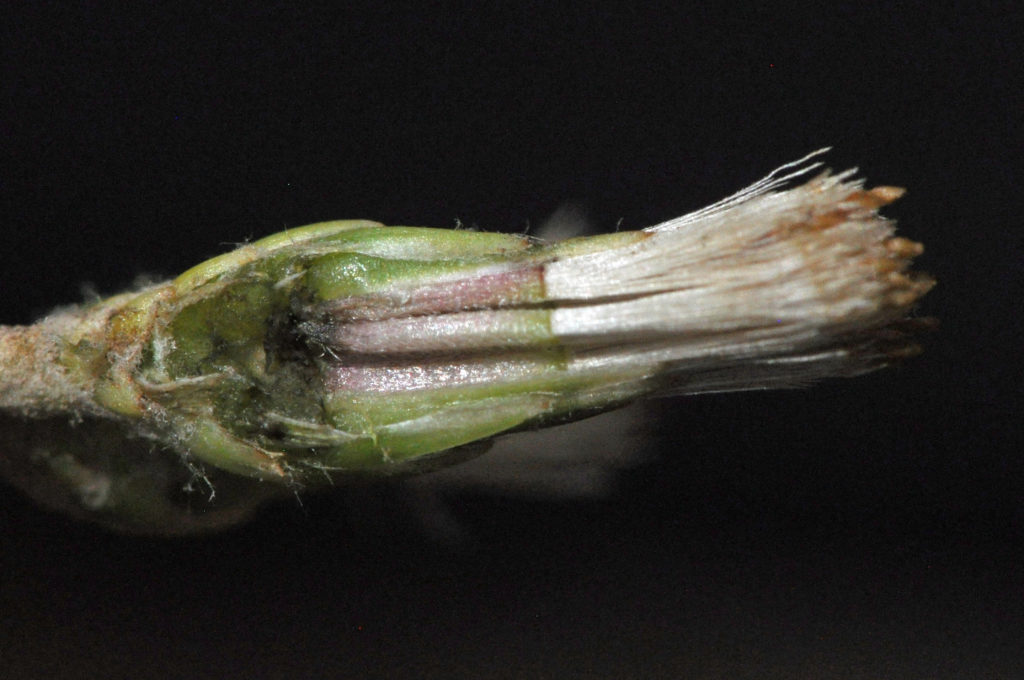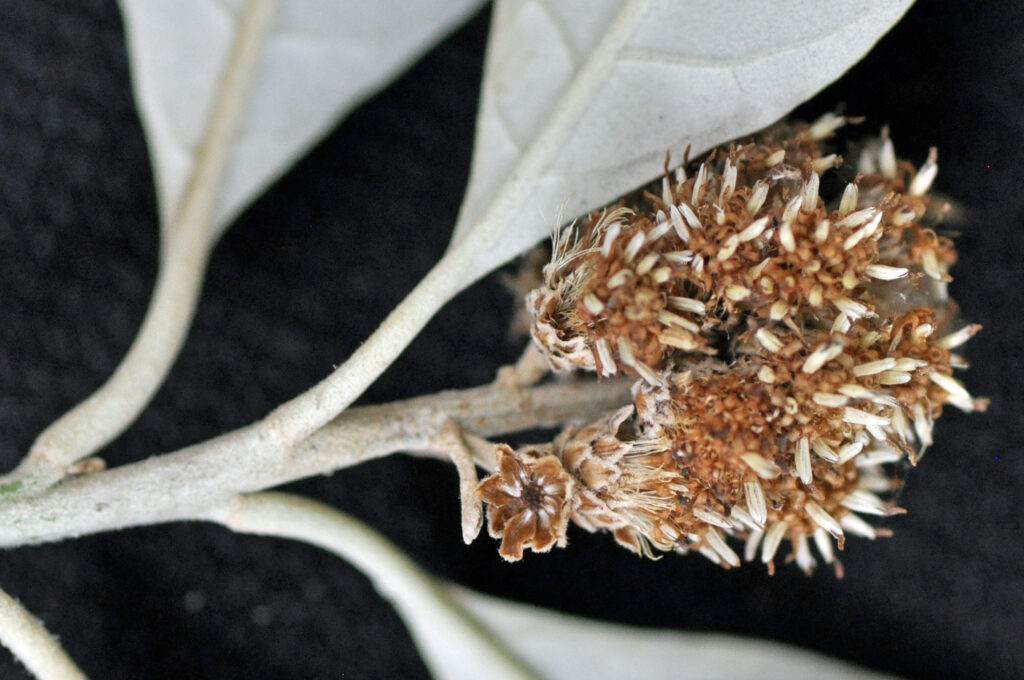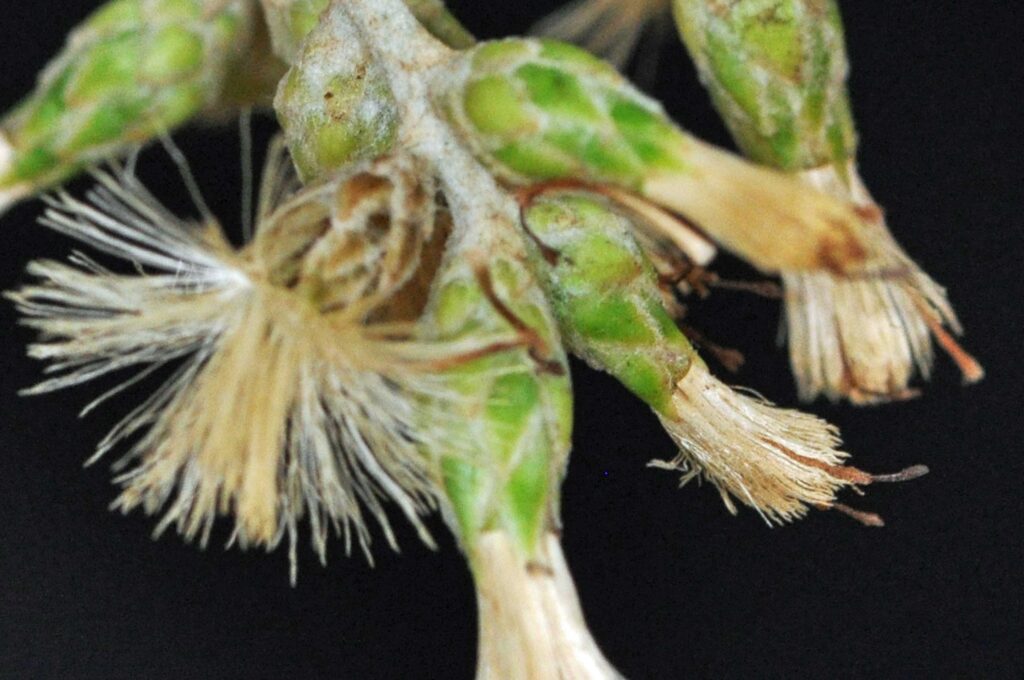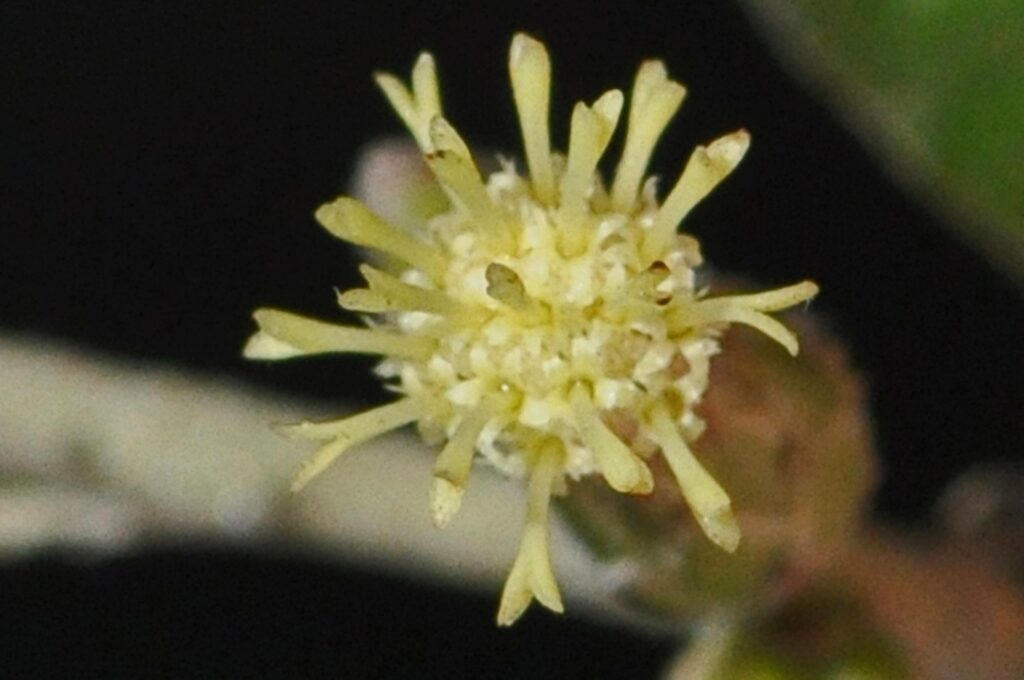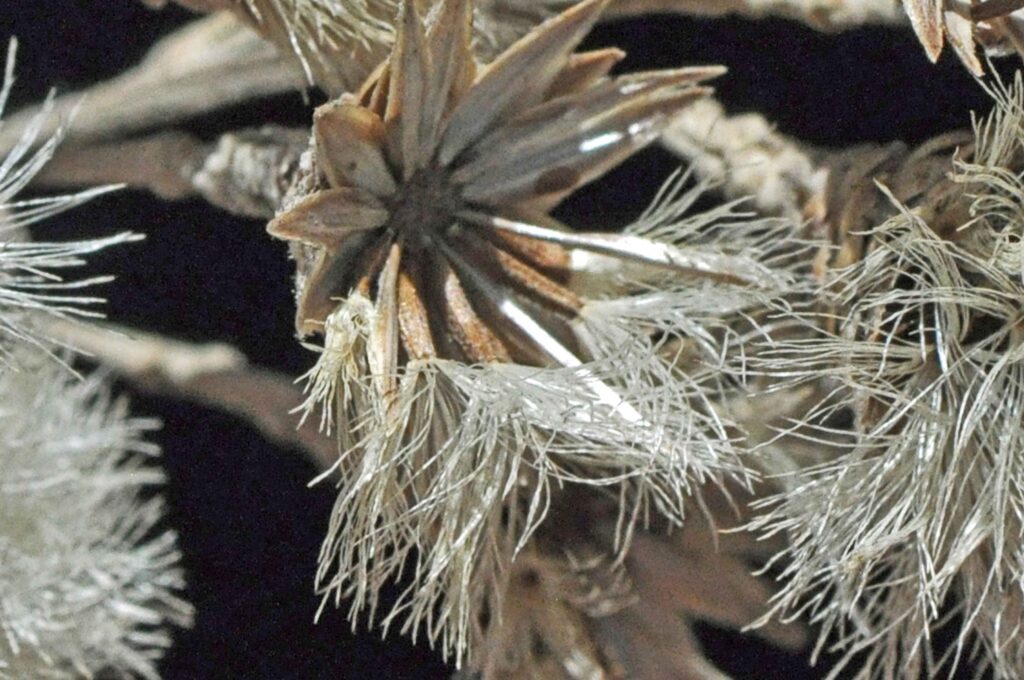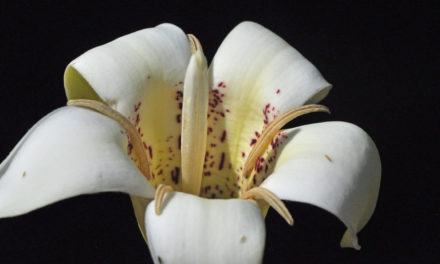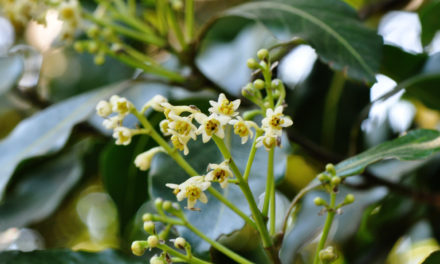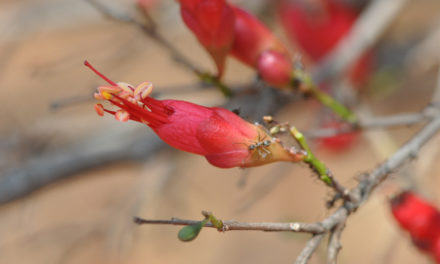General Info – summary
This common dioecious coastal Tree is a southern African endemic. The trunk has a diameter up to 45cm and is occasionally up to 29m high with a vertically fissured bark. It may be a dune shrub. Simple, bitter Leaves are discolorous. Shiny upper surface is hairless & densely velvety below. Tiny unisexual Florets (flowers) are in bracteate capitula. The Fruit is a cypsela. Seeds have a wind-dispersal apical pappus.
Description
Brachylaena discolor
Previous Names: Brachylaena discolor DC. subsp. discolor, Brachylaena discolor DC. subsp. discolor var. discolor, Brachylaena discolor DC. subsp. discolor var. mossambicensis Paiva, Brachylaena natalensis.
SA Tree No. 724.
Common names: (Afr) Bosvaalbos, Bruinivoor, Kusvaalbos, Voelpruim. (Eng) Coast Silver Leaf, Coastal Silver-oak, Forest Silver Oak, WildSilver Oak. (isiXhosa) Isiphaluga, Umphahla. (isiZulu) Iphahla, Isiphahluka, Umduli, Umphahla. (siSwati) Umphahla. (Tembe-Thonga) Apahla.
Family Asteraceae, Compositae. (Daisy family: includes sunflowers, lettuce, chicory, marigolds and Brachylaena). There are in excess of 1 900 genera and close to 33 000 species. This is possibly the second biggest plant family. In southern Africa, there are 246 genera and about 2 300 species. Local genera containing trees on this website include Brachylaena, Oldenburgia and Tarchonanthus. Some members have flowers grouped in heads and the whole head may appear to be a single flower – like the “sunflower”. Surrounding each flower are bracts. Individual Flowers in the Asteraceae are called Florets that usually have a base of 5 fused Petals. The Sepals are replaced by a Pappus (the modified calyx, the part of an individual floret, that surrounds the base of the corolla tube in flower heads of the plant family Asteraceae. The pappus may be bristle, plume, scale or awn like. In all members, the central florets are called Disc Florets. In some members, excluding Brachylaena, the outer florets (Ray Florets) are also present. These occur around the periphery of the flower. Ray florets are usually long and brightly coloured (like the yellow outer florets in the sunflower). Four or 5 stamens are fused to the corolla. An inferior Ovary is present containing 1 Ovule and the Style has 2 lobes. Each floret produces 1 Fruit with 1 Seed.
Name derivation: Brachylaena – short cloak: referring to the short floral bracts. discolour – different colours: referring to the 2-toned upper and lower leaf surfaces. There are 9 species of the genus Brachylaena in southern Africa. This genus is restricted to Africa, Madagascar and associated islands. All species of Brachylaena have flowers that lack ray florets and are dioecious (unisexual floral structures with functional male and female parts on separate plants).
Conservation: National Status: L C (Least Concern). Assessed: 2018. (L. von Staden).
Tree
This multi-stemmed shrub or single stemmed Tree is up to 12m high (usually less) and has a Trunk that may reach a diameter of 45cm. The tough, dark grey to reddish brown Bark becomes rough, hairless and vertically fissured (photos 1048, 340 & 347). The many indiscriminately arranged dark grey or reddish-brown untidy Branches (photo 347) may be grooved and may reach down to the ground (photo 360). The young branches are ribbed and white-felted with short-lived woolly white hairs (photo 904). Young branches may have visible pale Lenticels (usually raised corky oval or elongated area on the plant that allows the uncontrolled interchange of gases with the environment).
- 360. 2016/01/16. Pretoria NBG. Photo: David Becking.
- 1048. 2016/10/18. Pretoria NBG. Photo: David Becking.
- 340. 2015/10/13. Walter Sisulu NBG. Photo: David Becking.
- 904. 2018/03/01. Pretoria NBG. Photo: David Becking.
- 347. 2015/10/13. Walter Sisulu NBG. Photo: David Becking.
Leaves
On this evergreen or semi deciduous tree, the simple, alternate or spirally arranged Leaves are usually up to 12 x 6cm (photo 342). Leaves are variable in shape from oblong to lanceolate or elliptic to obovate even oblanceolate (the reverse of lanceolate, the leaf is broader at the apical third than at the middle and tapers towards the base) and occasionally oblong-elliptic. The thinly leathery Blade is discolorous (having upper and lower surfaces of leaves different colours). It is shiny dark green and hairless above (photo 342) and white/silvery with dense velvety hairs below – hence the species name discolor (photo 342). These discolorous leaves are distinctive and individual trees are recognisable from a distance – especially when the wind is blowing (photo 360 under Tree). The Midrib and lateral Veins protrude below (photo 344) and are sunken above (photo 342). The lateral veins often form a V-shape before they reach the margin (photo 344). The Margin may be wavy, almost entire (with a smooth edge and no teeth or notches), or obscurely to irregularly toothed in older leaves, especially closer to the apex (photo 342). The Apex tapers to a point (photo 342) or is almost rounded. The Base tapers narrowly. Here the tapering is slightly decurrent (partly wraps or has wings around the stem or petiole) here slightly down the hairy Petiole (leaf stalk) that is up to 2cm long – photo 344). Stipules (basal appendages of the petiole) are absent (photo 342).
- 342. 2015/10/13. Walter Sisulu NBG. Photo: David Becking.
- 344. 2015/10/13. Walter Sisulu NBG. Photo: David Becking.
Flowers/florets
In this tree, each inflorescence is a Capitulum (a flower head containing a dense cluster of up to 50 small Florets (flowers). Each large capitulum (intro photo) is about 11mm long and is supported by a short visible Peduncle (stalk of flower cluster – photo 345). Here the Involucre (whorls of visible green bracts – photo 1050) on each single capitulum is also visible. The capitula collectively form in a Panicle (an indeterminately, branched inflorescence – photo 345) that is up to 40cm long. The florets in each capitulum have a distinct Pedicel (stalk of a single floret) up to 5mm long. The capitula collectively form in a Panicle (an indeterminately, branched inflorescence – photo 345) that is up to 40cm long.
These trees are Dioecious (having male and female parts on separate plants) and the very small Florets are thus unisexual. Here the Sepals are replaced by a Pappus (modified Calyx) that is bristle-like (photo 1 050). When completely open these somewhat resemble a shaving brush (photo 1 050). In each Male floret, the 5 Stamens are attached to the style and surround the Stigma. The Anthers are calcarate (spurred), caudate (have a tail-like appendage and are introrse (the line of dehiscence, faces towards the flower centre). Male involucre is relatively large, and round to cup-shaped (photo 345). Here individual florets/flowers are up to 15 x 8mm and the Ovary is abortive. In the Female capitulum (photo 366) the Corolla has a dull tube ending with 5 tiny recurved, creamy white petal lobes that become recurved (photo 366). From the centre of each floret, the short exserted Style has 2 lobed branches that are flat to ovate-lanceolate (photo 366). Staminodes may be present. The inferior Ovary has a single ovule. (Jul- Sep).
- 108. 2017.09.19. Pretoria NBG. Photo: David Becking. Dissected..
- 345. 2015/10/13. Walter Sisulu NBG. Photo: David Becking.
- 1 050. 2016/10/25. Pretoria NBG. Photo: David Becking.
- 366. 2017/08/03. Pretoria NBG. Photo: David Becking.
Fruit
Each capitulum has numerous male or female florets. In photo 152 the capitulum has opened revealing many ripening female florets. The brownish to purplish Fruit is a Cypsela (a dry single-seeded fruit formed from a double ovary of which only one develops into a seed. Here the seed is up to 8mm long. It has an apical Pappus (modified outer perianth series of Asteraceae). The pappus has a tuft of rough creamy bristles (Photo 152). These bristles enable the seeds to be wind dispersed (photo 152). The tiny brown Seeds lack endosperm (starch and oil containing tissue). (Aug-Nov).
- 152 20152. 2016/10/25. Pretoria NBG. Photo: David Becking.16.10.25 Pretoria NBG. Photo: David Becking.
Distribution & Ecology
This drought resistant plant is common in coastal forest, riverine forests and dune bush e.g. near Port Alfred – SW of East London). It is also found at the edges of mangroves and northwards along the north-eastern coast of South Africa. Trees are Located in the Eastern Cape, KwaZulu-Natal, and marginally in Mpumalanga. They also occur up to the Lebombo Mountains in Limpopo, in southern Mozambique, Swaziland and Zimbabwe. It is thus a Southern African Endemic (restricted to a particular geographic location). On the dunes, it exists mainly as a shrub. Trees are absent in Namibia. Flowers, which may cover much of the tree, are rich in nectar. This attracts both insect, including bees and flies, as well as birds. Duiker, Bushbuck and Nyala may eat the Leaves. The trees may survive for 30 or more years. The leaves have anti-microbial properties.
Ethnobotany
The yellow, strong, very hard and durable Wood has a relatively low density and is used as floats for fishing nets. Other uses include making fishing spears, fence posts, boat building, hoe, pick and axe handles, hut building and for fuel. Zulu girls use the wood for constructing string bows. Here a gourd is used as a sounding box. The wood ashes are used as an alkali for soap making. The wood is suitable for carving. People and animals consume the vitamin C rich fruit. Young stems are used to make winnowing basket rims (Winnowing – separation – usually by wind) of more dense seed grain from their outer covering. This is a good Honey tree. Propagation is from cuttings and seeds. The plant grows easily and quickly from seeds and makes a good hedge plant and windbreak – especially in coastal areas. If fruit is wanted, both male and female plants are required. Using cuttings from both male and female plants is the best way to achieve this. This plant has non-invasive roots. Together with Mimusops caffra (coast red milkwood), these trees are planted for dune afforestation. The bitter tasting leaves are seldom grazed.
References
Boon, R. 2010. Pooley’s Trees of eastern South Africa. Flora and Fauna Publications Trust, Durban.
Burrows, J.E., Burrows, S.M., Lotter, M.C. & Schmidt, E. 2018. Trees and Shrubs Mozambique. Publishing Print Matters (Pty) Ltd. Noordhoek, Cape Town.
Coates Palgrave, M. 2002. Keith Coates Palgrave Trees of Southern Africa, edn 3. Struik, Cape Town.
Lawrence, G. H. M, 1951. Taxonomy of Vascular Plants. The Macmillan Company, New York. Tenth Printing 1965.
Palmer, E. & Pitman, N. 1972. Trees of southern Africa. Balkema, Amsterdam, Cape Town.
Schmidt, S. Lotter, M. & McCleland, W. 2002. Trees and Shrubs of Mpumalanga and the Kruger National Park. Jacana, Johannesburg.
van Wyk, B. & van Wyk, P. 1997 Field guide to Trees of Southern Africa, Struik, Cape Town.
von Staden, L. 2018. Brachylaena discolor DC. National Assessment: Red List of South African Plants version . Accessed on 2024/10/28.
http://www.plantzafrica.com/plantab/brachylaendiscol.htm
https://en.wikipedia.org/wiki/Brachylaena_discolor
http://kumbulanursery.co.za/plants/brachylaena-discolour
http://apps.kew.org/efloras/namedetail.do?taxon=4688&nameid=11353
http://posa.sanbi.org/flora/browse.php?src=SP

